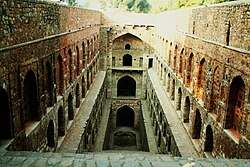This is an old revision of this page, as edited by Sitush (talk | contribs) at 21:32, 30 August 2016 (Reverted to revision 731537326 by Bender235 (talk): Last best version - unsourced and the grammar is worse, not better. (TW)). The present address (URL) is a permanent link to this revision, which may differ significantly from the current revision.
Revision as of 21:32, 30 August 2016 by Sitush (talk | contribs) (Reverted to revision 731537326 by Bender235 (talk): Last best version - unsourced and the grammar is worse, not better. (TW))(diff) ← Previous revision | Latest revision (diff) | Newer revision → (diff) For other uses of Aggarwal, see Aggarwal.Ethnic group
| Regions with significant populations | |
|---|---|
| India | |
| Languages | |
| Hindi, Marwari, Punjabi, Haryanavi | |
| Religion | |
| Hinduism · Jainism |
Agrawal (Agarwal, Agrawala, Agarwala, Aggarwal, Agrawal) is a community found throughout northern India, including in Haryana, Punjab, Rajasthan, Delhi, and Uttar Pradesh. Before the partition of India in 1947, people of the community were also found in modern day Punjab province of Pakistan.
The texts and legends of the Agrawal community trace the origin of Agrawals to the legendary king Agrasena of the Solar Dynasty who adopted Vanika dharma. Literally, Agrawal means the "children of Agrasena" or the "people of Agroha", a city in ancient Kuru Panchala, near Hisar in Haryana region said to be founded by Agrasena.
Members of the Agrawal community are known for their business acumen and have for many years been influential and prosperous in India. Other related communities include Maheshwaris, Khandelwals, and Oswals.
Legend
Main article: AgrasenaThe Agrawals claim descent from king Agrasena of the mythological Solar Dynasty who adopted Vanika dharma for the benefit of his people. Literally, Agrawal means the "children of Agrasena" or the "people of Agroha", a city in ancient Kuru Panchala, near Hisar in Haryana said to be founded by Agrasena.
History

During the eras of the Mughal empire and the British East India Company administration, some Agrawals migrated to Bihar and Calcutta, where they became a major component of the Marwaris.
Agrawals during the Mughal era
Some Agrawals rose to prominent positions in this period. Sahu Todar was a supervisor of the royal mint at Agra, who had rebuilt the 514 Jain stupas at Mathura in 1573, during the rule of Akbar.
Todar Mal, who was one of the Navaratnas of Mughal emperor Akbar's Darbar, may have been an Agrawal. He became the Finance Minister of the Mughal empire.
Sah Ranveer Singh was a royal treasurer during the rule of Akbar. He was awarded a jagir in western UP, where he established the town Saharanpur. His father as well as son and grandson had built several Jain temples, including the one at Kucha Sukhanand in Delhi.
Lala Ratan Chand became the diwan of Mughal emperor Farrukhsiyar (1713–1719) in 1712, and was given the title of Raja. He was associated with the Saiyid Brothers, who served as the king makers for several years, and became involved in the court intrigues. He was executed during the battle of Hasanpur by the order of the new emperor Muhammad Shah (1719–1748) in 1719. He became the founder of the Rajvanshi Agrawals.
See also
References
Notes
- J. P. Mittal considers Agrasen to be an actual historical figure, not mythological
Citations
- Gulzar Ahmed Chaudhry (4 June 2014). "Nagar Mahal – from Agarwals to Sukheras". Dawn.
- Julka, Harsimran; Radhika P. Nair (12 February 2013). "Why young Aggarwals dominate India's e-commerce start-ups". The Economic Times. Delhi.
- Gore, M. S. (1990). Urbanization and Family Change. Popular Prakashan. p. 70. ISBN 9780861322626.
- ^ Mittal, J. P. (2006). History of Ancient India: From 4250 BC to 637 AD. Atlantic Publishers. p. 675. ISBN 9788126906161.
- Sarda, Har Bilas (1935). Speeches and Writings. Ajmer: Vedic Yantralaya. p. 120.
- "Agrasen Ki Baoli, un oasis au coeur de la capitale | Inde Information". Aujourdhuilinde.com. 22 August 2007. Retrieved 3 November 2011.
- "Monuments – Delhi Monuments – Tourist Information of India – Lakes, Waterfalls, Beaches, Monuments, Museums, Places, Cities – By". Tripsguru.com. Retrieved 3 November 2011.
- Anne Hardgrove, Community and Public Culture: The Marwaris in Calcutta, New Delhi, Oxford University Press (2004) ISBN 0-19-566803-0
- ^ Jyotiprasad Jain, Pramukh Jain Etihasik Purush aur mahilayen, Bharatiya Jnanapitha, 1975
- Dwarka Nath Gupta (1999). Socio-cultural History of an Indian Caste. Mittal Publications, New Delhi. p. 15.
Two of Akbar's finance ministers - Madhu Sah and Todar Mal are said to have been Agarwals
- Sebastian, Sunny (26 March 2006). "A festival that takes you to Akbar era". www.thehindu.com. The Hindu. Retrieved 1 August 2014.
The beginning of `mela' goes back to 1851. Raja Todarmal, the Minister of Akbar, was the Badshah in the `mela'. According to legend, the Emperor had given a boon to Todarmal to be in his place for a day. This is the commemoration of that event," Rajesh Chouhan, Sub-Divisional Officer, Beawar, said talking to this correspondent. A person from the Agarwal community got the privilege to don the mantle of the emperor as Todarmal was believed to be from the community, Mr.Chouhan explained.
- History of Origin of Some Clans in India, Mangal Sen Jindal, Pub. Sarup and Sons, 1992